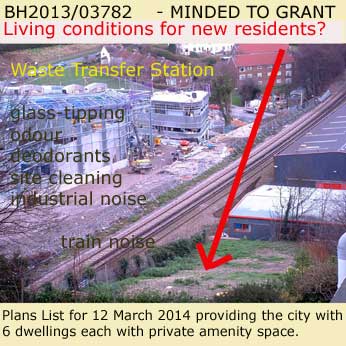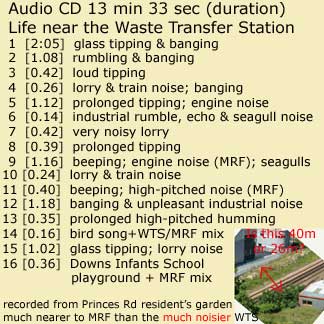This page is from the Round Hill Society archives which are available for historic interest. Please bear in mind when viewing archived pages that details may no longer be current.
Carelet 2014 minded to grant
The planning committee voted to follow the officers' advice.
Carelet's proposal BH2013/03782 approved

Concerns about the officers' recommendation
Dear planning committee members,
The appeal decision relating to a refused proposal (BH2007/04444) is quoted selectively in paragraph 8.7 of the Planning Committee List [12th March 2014] to support an application (BH2013/03782) requesting a considerable amount of extra bulk i.e. height increases ranging between 3ft 11 and 4ft 9 over six proposed properties.
It needs to be made clear that the appeal against refusal of BH2007/04444 was dismissed. The planning inspector found that because of the presence of the Waste Transfer Station an excessively bulky scheme (as he considered BH2007/04444 to be) was unacceptable in terms of the amenity and quality of outlook offered to future occupants. Since Roger Mather's appeal decision, delivered on 21st October 2008, the permitted operating hours of both The Waste Transfer Station and The Materials Recovery have been extended and noise & odour nuisaces are now well known to immediate residents.
Update from Round Hill resident: following Veolia's successful application in 2013, permitted operating hours at both The Waste Transfer Station and The Materials Recovery Facility now extend to up to 15 hours per day on 363 days in the year. For all but two days per year, there is now only a guarantee of 9 hours in the night when the delivery, processing & moving on of domestic waste and recyclables is not a potential noise nuisance. Odour nuisance is not regulated by night-time hours, but hits during periods of sunny weather (e.g. some loads are very smelly when they arrive because of late street collections), during periods of peak activity and when the wind is blowing from the industial facility towards homes and gardens - the odour particles are carried in wafts.
In the planning inspector’s judgement, future occupants (not existing residents) would have suffered unacceptably from overlooking and loss of privacy.
Future occupants & overlooking
Planning inspector, Roger Mather’s concerns (see paragraph 16 of his decision) relate to a scheme designed to adhere to back-to-back distance of 20m separations. Paragraph 8.7 of Planning Committee List for BH2013/03782 should raise added concerns: with the extra height requested, we are now looking at separations which are nearer to 18m in places.
Roger Mather's appeal decision addresses the key issues which would be helpful to your decision on BH2013/03782.
It’s main relevance is that next Wednesday you are being asked to approve extra bulk (in the form of height to save on the cost of excavating deeper foundations).
Paragraph 8.7 in The Planning Committee List is there to support the request for extra height and to argue that its impact would be acceptable.
I do fear that you may be led in the wrong direction by the statement in paragraph 8.7 that the appeal (following the refusal of BH2007/04444) was not dismissed on the grounds of loss of amenity.
The true conclusion of Roger Mather’s appeal decision states clearly that IMPACT ON AMENITY is one of his main reasons for dismissing the appeal. Nowhere is this made clear in The Planning Committee List. Surely some consideration needs to be given to the amenity of future occupants.
The true conclusion to Roger Mather’s appeal decision is found in its penultimate paragraph:
21. Overall, while there are some factors in favour of the proposed development, I find the scheme would seriously compromise the character and appearance of the Round Hill Conservation Area, giving rise also to increased parking stress, as well as impairing the living conditions of future occupants. These considerations are of overriding importance and outweigh all others. Consequently, I further conclude that the appeal should not succeed.
I find it disappointing that paragraph 18 of the appeal decision is seized on in the Plans List without any reference to paragraph 16, which references 20m separations between existing and proposed, the loss of privacy and overlooking (from existing homes to the south) which future occupants would experience, and their poor outlook on the northern side.
Extra bulk & The Waste Transfer Station
Very relevant to BH2013/03782, is Roger Mather’s statement that the presence of The Waste Transfer Station alone would not warrant withdrawing permission. The unacceptable outlook arises through a combination of overdevelopment (i.e. too much bulk) and the presence of The Waste Transfer Station, both factors together.

Following, this clear rejection of a three-storey and two-storey mix of houses, the applicant then (in 2009) put in for four two-storey houses and worked with the Council’s ecologist to produce a landscaping plan which would provide greater amenity for residents, while protecting the green spaces characteristics of the Round Hill conservation area as seen from views into it from the north. These conservation assets are in fact valued in paragraph 10 of Roger Mather’sappeal decision.
I do recommend that the appeal decision is read in its entirety. Paragraphs 13-15 raise doubt that a development on this site could be traffic-free.